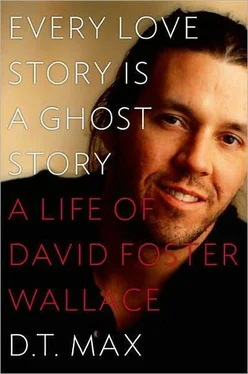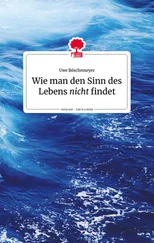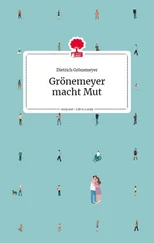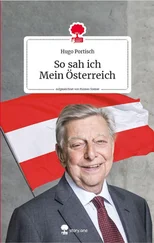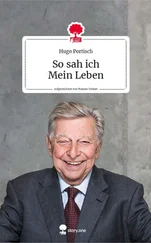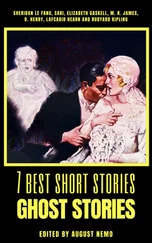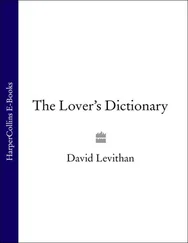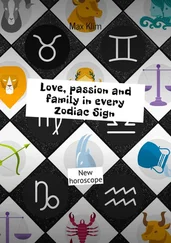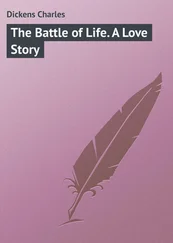Since junior year of college, Wallace had never been without a girlfriend for very long. These women filled an important gap in his life. They were the clock by which he noted time’s passing and the mirror in which he examined his character. When he was having problems with Karr back in Syracuse, for instance, he had written to Franzen, “I’m having to countenance the fact that I just may be constitutionally unable to sustain an intimate connection with a girl, which means I’m either terribly shallow or mentally ill or both.”
As the summer wore on, Wallace was still getting his ex out of his system. His male friends in Syracuse had been enormously relieved when ISU had offered him a job; to them the Karr relationship seemed wholly dysfunctional. “Run for your life,” his sponsor, John F., remembers telling him. He now affected to have left Karr behind in letters to friends. “Unpacking, trying to write, chasing tail,” he boasted to Morrow, summarizing his activities his first summer in Illinois. But in fact several months after arriving many of his thoughts were still of Karr; he bought her expensive lingerie and perfume and mailed it anonymously. He even bought the right to name a star after her. He wrote in a notebook, “Now she’s in the sky and a little bit of her will always be overhead.” He sent her the box with the certificate. Around the same time, he wrote a Syracuse friend that he was “off sex” and promised himself he would never be in such a poisonous relationship again. “I won’t sleep with anybody who lives far away anymore,” he wrote her, “whom I can’t be with — I hope — from now on.”
Fortunately, his department head, Charlie Harris, and Harris’s wife, Victoria, also a professor of English at ISU, stepped in. Victoria had their twenty-four-year-old daughter Kymberly in mind for Wallace. Kymberly was an actress and aspiring playwright who lived in Chicago. On Wallace’s first visit Victoria had shown him her picture. “Isn’t she beautiful?” she’d said. “You should marry her.” The two began corresponding, and soon Harris, leaving behind personal problems in Chicago, had moved home. Wallace and her mother invited her out the next day to a movie. He chose Jurassic Park . The three went to downtown Normal’s theater to watch the blockbuster. Wallace was, as ever, also doing research. Steven Spielberg, the movie’s director, was someone Wallace had always been interested in. Though he’d seen the movie twice before in Syracuse, he enjoyed it again, getting, as he would say, his “dose.” Kymberly, on the other hand, had been so bored she’d walked out. Afterward, they went to the Gallery, a club where Wallace refused to join her on the dance floor. Despite their differences the two began hanging out; Wallace gave her sections of Infinite Jest to woo her, and soon they were a couple. In the empty Midwest, she felt, he was the most interesting man she knew; Wallace enjoyed her vibrancy and physicality.
Both in therapy, they spent a lot of their time discussing their painful pasts and how they had come to be the way they were — a catalog of ex-lovers and family, with Wallace focused on Karr and his mother. They talked about wanting community and children. Kymberly was astonished at the intense way Wallace listened. He had become interested in Buddhism through a woman he met in Syracuse and gave Kymberly works on the religion that had been suggested to him, plus the Big Book. One day Victoria Harris found them deep in conversation on the couch in the Harrises’ living room. “Stop talking about your relationship and start having it!” she admonished them.

Michael Pietsch read the portion of Infinite Jest that Wallace sent as soon as he got it in May 1993. He made his way through the 750 pages Wallace had mailed off and responded just as Wallace was getting ready to leave Syracuse. His letter was remarkably insightful, given how little time he’d been able to spend thinking about the partial manuscript of a very complicated book:
You ask what I think it’s about. Since it’s not all here my answer to that (and all my suggestions) will have to be tentative…. It’s a novel made up out of shards, almost as if the story were something broken that someone is picking up the pieces of. This fits with the broken lives the novel’s about; also as a way of recreating two worlds, the halfway house and the tennis academy….[O]ccasionally there surfaces through the stories an “I” who may be the one trying to put everything together.
Pietsch wrote Wallace that he was “seriously loving being inside” the “huge roiling story about addiction and recovery, their culture and language and characters, the hidden world that’s revealed when people come in and tell their stories.” But he also saw a major problem on the horizon: length. Good as it was, the book was on its way to being too long. Wallace had tried to trick him with narrow margins and a tiny font in sending the first 400,000 words, but Pietsch had pulled out a calculator and tallied that if what he had on his desk was two-thirds of the finished book, Infinite Jest would be twelve hundred pages, at the least. He doubted the marketability of such a tome. “This should not,” he lectured Wallace, “be a $30 novel so thick readers feel they have to clear their calendars for a month before they buy it.” He urged Wallace to “try cutting now,” even while he finished his story. His other major editorial worry related to the physics of reading. The fragmentary structure of the book — three plot strands that seemed to come to the fore and then recede without pattern — was a lot. A little structural innovation was enriching, but too much and you lost the reader entirely. This was a harder problem for Wallace to solve, because the book consistently confounded the reader’s expectations on purpose. If reality was fragmented, his book should be too. It was also in keeping with Wallace’s insistence that the story not be so amusing that it re-create the disease he was diagnosing. It must not hook readers too easily, must not allow them to fall into the literary equivalent of “spectation.” Infinite Jest had to be, as he subtitled it, “a failed entertainment.” To the extent the novel was addictive, it should be self-consciously addictive. That was one reason he’d structured the story like a Sierpinski gasket, a geometrical figure that can be subdivided into an infinite number of identical geometrical figures. The shape of the book — following Wallace’s natural cast of mind — was recursive, nested. Big things— Infinite Jest , a novel you keep having to reread to understand — find their counterpart in smaller things: “Infinite Jest,” the video cartridge, which itself plays in an endless loop. One character fears she is blind, so she never opens her eyes. Another has an answering machine message that is like one of those infinite man-holding-a-book-whose-cover-is-the-man-holding-a-book visual regressions: “This is Mike Pemulis’s answering machine’s answering machine.” The effect is to emphasize the characters’ isolation, their lives in a funhouse that isn’t all that fun. As in Broom , the apparent casualness of the structure was intensely thought through.
What Pietsch found most off-putting was the political overlay Wallace had given the book centering on the attempts by Quebecois terrorist groups to wrest back their province from O.N.A.N. “Almost everything that matters emotionally works without reference to the time frame or the interAmerican huggermugger,” Pietsch noted, wondering about the necessity of what he called “the ornately bizarre-to-goofy superstructure” of the book. He warned, “the dog is awfully shaggy already.” The letter left Wallace upset and unsatisfied. “He seemed to agree with most of it, glumly,” Pietsch scribbled on a copy of the letter he later sent to Nadell.
Читать дальше
